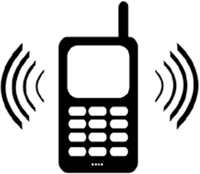Authors: Dan Lewis
Now I Know More (18 page)
When whales get stressed, they release a hormone that, ultimately, they excrete in their feces. Because researchers were collecting the poop on 9/11 and the days previous and subsequent, the science community had data on the relative stress levels of the Bay of Fundy whales during that time. What it shows is that the whales were pretty relaxed on the days after the attackâor, at least, more relaxed than they were in the days prior.
From the same time period, we also have data measuring the amount of low-frequency acoustic signals in the Bay that weekâagain, from before and after 9/11. We already knew that ship traffic came to a near-halt, so it shouldn't be surprising that the amount of underwater noise also dropped dramatically. One could say that it was, relatively speaking, rather peaceful if you were a whale.
Whether the whales' stress levels are important, though, is harder to determine. Since the conditions of this experiment were accidental, researchers can't repeat the tests. One of the researchers pointed out, in the words of the Associated Press, that it is “unclear how much chronic stress from noise the whales can take before the population is affected, largely because it's impossible to conduct controlled experiments on fifty-ton animals.” So for now, we'll likely keep stressing out the whales.
Life as a college student can be stressful, too, especially around finals. A few schools have found a cute solutionâpuppies. The schools bring in trained therapy animals to take some of the edge off.

HOW YOUR CELL PHONE MAKES YOU HAPPIER BY LYING TO YOU
You're on your cell phone, talking about something or other. Suddenly, you realize that the other person is strangely quietâtoo quiet. “Still there?” you ask the void, hopelessly, as you already know the answer. The other person didn't just stop talking. Your call has been disconnected.
Again, you knew that already. But
how
did you know that?
The answer: your cell phone provider tricks you. (In a good way, though.)
When we have real, in-person conversations, it is rarely, if ever, in a place of true silence. Perhaps an air conditioner is running or birds are chirping or someone is rustling papers quietly at his or her desk. These tiny background sounds aren't interrupting your conversations, though. Subconsciously, we anticipate them (this is often, in aggregate, called “white noise”), and they act as a signal to our brains that all's normal. However, communications that aren't in personâcell phones and radio, especiallyâdon't have this white noise. Sure, there are the background sounds in the area in which we're standing or sitting, but when the speaker is in another area, that doesn't do us much good.
So we fake it. Or, rather, the cell phone companies do, by adding what is called “comfort noise.” Wikipedia defines it as “synthetic background noise used in radio and wireless communications to fill the artificial silence.” It's not the easiest thing to provide. All the sounds we hear on our cell phones are just data bits being translated into sound, and transmitting that data takes up bandwidth. This is true for real conversations and comfort noise alike, so many companies are in the business of optimizing this useful static.
And no, eliminating comfort noise isn't an option; that would lead to a surprising number of “hello?”s and “you there?”s. According to one provider of comfort noise, “most conversations include about 50 percent silence.”
Radio was an incredibly important form of mass communication during World War II. For example, before and after air raids, the city of Leningrad broadcast instructions to take cover, and later would issue the all-clear, over a municipal radio service. That radio system reached most of the city; it had about half a million households and businesses with speakers, and another 10â20,000 loudspeakers on the street. What if the Germans bombed the transmitters? How would the people of Leningrad know? To account for this, the city radio employed an early version of comfort noise, softly broadcasting the sound of a metronome when no announcements were being made.

WHY WE THINK OUR PHONES ARE VIBRATINGâEVEN THOUGH THEY AREN'T
You're sitting at your desk, standing in the kitchen, watching TV, etc. All of a sudden, your cell phone vibrates, informing you that you have a new text message, phone call, or e-mail. You reach into your pocket and check, only to find no such messageâand perhaps you discover that your phone is not even in your pocket. The vibration felt real, but what caused it? Evidently, not your cell phone.
If this has happened to you, rest assured you are not alone.
In 2010, a team of researchers from Baystate Medical Center in Springfield, Massachusetts, asked 232 of their colleagues to answer a questionnaire about phantom vibrations from their cell phones (or, more correctly, from the area where their cell phones usually are). Of the 176 who responded, 115â69 percentâstated that yes, they experienced the disconcerting fake alerts like those just described. The researchers' plain-as-day conclusion: “Phantom-vibration syndrome is common among those who use electronic devices.”
What causes it? There are a lot of theories. Discovery News suggested that “[it] could be because cell phones produce electrical signals that transmit the feeling of vibration directly to a person's nerves or simply because of the mental anticipation of alerts.” Mental Floss explains one way this might work, likening it to “a physical stimulation similar to what happens when your phone is near a speaker and you hear that weird buzzing sound as it does a âhand shake' with a cell tower and gives off some electromagnetic interference.” The anticipation is not dissimilar from any other sort of psychological conditioningâwe are so used to our phones vibrating that our brains make it feel like it is happening when we expect it, not when it actually does.
There's some newer evidence suggesting that these false vibrations are all in our heads. In July 2012, researchers published a study on the phantom-vibration phenomenon after speaking with undergraduate students about the fake shakes. The majority of the students experienced the vibrations, but, as
Slate
magazine explains, the study found it happened more often to extroverts and neurotics:
Extroverts, the theory goes, check their phones a lot because keeping in touch with friends is a big part of their lives. Neurotics, meanwhile, worry a lot about the status of their relationshipsâso while they may not get as many text messages, they care a lot about what they say.
In any event, most researchers think that the fake vibrations are harmless (albeit annoying)âalthough there has been very little research into that.
The 1969
Apollo 11
moon landing is a favorite topic of conspiracy theorists who assert that the landing was faked and instead filmed on a sound stage. In September 2002, one such conspiracy theorist physically accosted the second man on the moon, Buzz Aldrin (whose mother's maiden name was Moon!), demanding he swear upon a Bible (that the conspiracy theorist brought with him) that the landing was faked. Instead, Aldrin punched the guy. Authorities declined to press charges against Aldrin.

CLICKING FOR SAFETY
Take out your cell phone and take a picture. If the sound is on, you may hear a shutter soundâsomething (if you're old enough) reminiscent of the nondigital cameras of yesteryear. That sound is artificial, and likely included to bring the full camera-like experience to the digital world. With most phones, if you want to turn off the sound, you can. Apple's iPhone 3G, for example, has no shutter sound if you put your phone in silent mode.
Except in Japan.
As the Apple-aficionado site Cult of Mac reported, the digital revolution led to a perverse de-evolution of proper public conduct among some Japanese. The new trend? “Upskirt” and “downblouse” photos of women, taken without their permission and often without their knowledge. To make this violation worse, the increasing popularity of social media means that a victim's image could spread widely, potentially with enough context to identify the person depicted. The problem got so out of hand that most subway stations now have signs warning to “Watch out for upskirting.”
To help prevent this, the Japanese version of the iPhone 3Gâand many subsequent modelsâkept the shutter sound even if a user set the phone to silent. While this wouldn't stop the most brazen upskirt photogs, the hope was pretty clear. At the very least, it would draw attention to what they were doing.
So far, this requirement isn't widespread outside Japan. However, in 2009, U.S. Congressman Peter King wanted to do the same thing in the United States, introducing a bill called the Camera Phone Predator Alert Act, which, if enacted, would “require mobile phones containing digital cameras to make a sound when a photograph is taken.” The bill did not receive support from any other legislators and never became law.
But even if the bill were to have become law, it wouldn't have mattered much, if Japan is any indicator. Those intent on taking such photos surreptitiously have found workarounds. For phones running Google's Android operating system, there are apps that, according to the
Daily Mail,
override the system settings and mute the shutter sound. There's an even easier work-aroundâfor most phones, using a headset pushes all noise to the ear buds, effectively muzzling the sound.
In August 2010, Boston police set up a sting operation to catch a man who was reported to be taking upskirt photos in the city's subway system. The case made its way to the highest court in Massachusetts, which, on March 5, 2014, ruled that the man wasn't guilty of anythingâthe law only pertains to photographs taken of subjects who are at least “partially nude.” The court ruled that “a female passenger [. . .] who is wearing a skirt, dress, or the like covering these parts of her body is not a person who is âpartially nude,' no matter what is or is not underneath the skirt by way of underwear or other clothing.” If you think that's ridiculous, you're not aloneâthe Massachusetts government passed a revised version of the law two days later.

